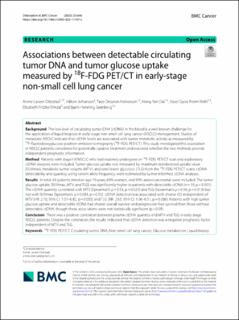| dc.description.abstract | Background
The low level of circulating tumor DNA (ctDNA) in the blood is a well-known challenge for the application of liquid biopsies in early-stage non-small cell lung cancer (NSCLC) management. Studies of metastatic NSCLC indicate that ctDNA levels are associated with tumor metabolic activity as measured by 18F-fluorodeoxyglucose positron emission tomography (18F-FDG PET/CT). This study investigated this association in NSCLC patients considered for potentially curative treatment and explored whether the two methods provide independent prognostic information.
Method
Patients with stage I-III NSCLC who had routinely undergone an 18F-FDG PET/CT scan and exploratory ctDNA analyses were included. Tumor glucose uptake was measured by maximum standardized uptake value (SUVmax), metabolic tumor volume (MTV), and total lesion glycolysis (TLG) from the 18F-FDG PET/CT scans. ctDNA detectability and quantity, using variant allele frequency, were estimated by tumor-informed ctDNA analyses.
Results
In total, 63 patients (median age 70 years, 60% women, and 90% adenocarcinoma) were included. The tumor glucose uptake (SUVmax, MTV, and TLG) was significantly higher in patients with detectable ctDNA (n = 19, p < 0.001). The ctDNA quantity correlated with MTV (Spearman’s ρ = 0.53, p = 0.021) and TLG (Spearman’s ρ = 0.56, p = 0.013) but not with SUVmax (Spearman’s ρ = 0.034, p = 0.15). ctDNA detection was associated with shorter OS independent of MTV (HR: 2.70, 95% CI: 1.07–6.82, p = 0.035) and TLG (HR: 2.63, 95% CI: 1.06–6.51, p = 0.036). Patients with high tumor glucose uptake and detectable ctDNA had shorter overall survival and progression-free survival than those without detectable ctDNA, though these associations were not statistically significant (p > 0.05).
Conclusion
There was a positive correlation between plasma ctDNA quantity and MTV and TLG in early-stage NSCLC patients. Despite the correlation, the results indicated that ctDNA detection was a negative prognostic factor independent of MTV and TLG. | en_US |

